Uachtar Ard was well named as it translates from Gaelic to mean A high place, The Round Tower at Uachtar Ard rests beside the ruins of an old church ruin on a quite hill top in Kildare. It is associated with an ancient monastic settlement believed to have been founded here, way back in 605AD by a Saint Briga? It took me some research to check this important fact, as I initially believed that Briga was the Brigid whom also founded the famous monastery in Kildare Town. But this is not so. In fact records show that there were a number of Brigid’s taken from the martyrologies and heroic literature, whom can only be identified by their feast day, so far I have been able to identify 14 individuals known as Brigid or various spellings of the name. So Briga, was the daughter of Congall, and said to have been a good friend of Brigid of Kildare. Some of the information about the great history and archaeology of this great site comes from the guys at Abarta Heritage. Please take a moment and check out the link at the end of this post where you can hear the story for yourself with their free audio guides.
The site is also associated also with another sixth century female saint, Saint Derchairthinn whom was a descendant of Cairbre Lifechair via the Colla Uais line. This monastery was under the patronage of a local branch of the Uí Dúnlainge dynasty whom held the kingship of Leinster between 750 & 1050 A.D. The hilltop monastery and round tower were burned by the Dublin Vikings under Sigtrygg Silkbeard in 995. There is a reference to another raid in 1094 mentioned in the Annals of the Four Masters, but nothing else known of it. During the Norman invasion of Ireland in 1169–71 the parish was a part of the large estates given as a dowry by Dermot McMurrough on the marriage of his daughter Aoife to Richard De Clare in 1170.
Uachtar Ard or Ougherard became a Royal Manor and Borough in the 12th century. Next it was owned by Adam de Hereford, who willed all his lands to St Thomas monastery in Thomas Street, Dublin, and died in 1210 A.D. For several centuries the monastery rented the land to tenant farmers until the Dissolution of the Monasteries in 1536–41. According to recent research by the archaeological historian Mike O’Neill, the current ruined church on the site dates back to 1350AD and not 1609 A.D. as previously thought. Following the Cromwellian conquest of Ireland in 1649–53, land had to be surveyed and then often confiscated from parliament’s opponents to pay its debts under the 1642 Adventurers Act.
Situated not far from Ardclogh I followed the road up a hill for about 2 km before veering off to the right. The main entrance is quite easy to miss as it is located in between two residences which surprisingly I also drove by, not noticing the site until I had driven well past it. I was able to park the car on the verge opposite the entrance. The gate is marked Oughterard Cemetery. When I visited, the gates were locked but access can be had via and old-fashioned turnstile leads to a short trail up the remainder of the hill to the site of a very old graveyard, surrounded by a high wall which also contains the ruins of an old church and the round tower. The gates into the graveyard where also locked, but I was able to climb the wall via an ancient stile. The grounds of this site are kept extremely well and the first thing that struck me was the vast amount a slab marked graves, which I have not seen in such abundance anywhere on my numerous explorations.
The Round Tower which dates back to the 8th century is in quite a bad state with only the lower eight meters still standing. Aside from a burning in the attack of 1096, there is little is recorded about the site and the round tower is not mentioned until 1792 in ‘An Eighteenth Century Antiquary’ by Austin Cooper whom was Deputy Constable of Dublin castle. This is one of five such Round Towers which can be found in Kildare, the others reside at Old Kilcullen, Kildare Town, Taghadoe and of course Castledermot. It looks almost the same as described back in 1792. The last visible remains of the early Christian settlement, it was constructed mostly from limestone masonry. The door which there is no access to unlike the one at Brigid’s Cathedral in Kildare town stands approx. 2.5 meters above ground level. It faces east and is round-headed, built from granite with inclining jambs. You can just about make out the three floor-levels with one round-headed window surviving on the first-floor level facing south. The round tower is a National Monuments and in State ownership.
Whilst the first half of the church is in a bad state of ruin, entry into the second part of the church is quite dark. The main window on the east side of the church is still intact but sheds little light into the room. What appears to be a table top style tombstone can be found directly underneath the window. The surviving church remains consist of the lower portions of the walls of a 12th century Nave, abutted by a large barrel vaulted chancel from around 1350 A.D. Access used to be via the chancel arch, built from Tufa, (a variety of Limestone). The arch was blocked up over the years and a square-headed, granite doorway was inserted into it. On the chancels south facing wall, there is a turret containing a stairway which leads up to the top of the barrel vaulted roof. This may have been added to the structure around the same time that the chancel arch was blocked up, but today it is falling away from the main structure and is supported by two concrete buttresses to stop any further movement.
Being the dare devil that I am I decided to climb the turret and safely made my way out onto the roof. The steps leading up seem to be constantly wet and it can be quite slippy in parts, so I would advise using extreme caution, if you attempt the climb. It gets surprisingly windy up there, but there are some magnificent views of the surrounding landscape to be had from up there, if you have the head for it. From here you can really see a better layout of the graveyard and make out where the vaulted tombs are. Moving on to the Nave which was built using large blocks of roughly coursed limestone with a limestone quoin in the north east corner. The original entrance is not known, but a sketch from Cooper’s book, shows a porch on the south wall, the north wall contains a blocked, round-arched doorway near its centre. The nave was lit by a narrow, round-headed window with a chamfered granite arch in the west gable wall, and there are faint signs of a window-splay and tufa jambs towards in the S wall. Above the west gable is the remains of the bell cote.
As you stroll around this graveyard there are numerous grave stones dating back from ancient time’s right up to the modern era. Most of the legible burial markers date from the 18th century, with the earliest recorded death in the year 1700. There are also two rather interesting crosses to be found. One could almost be mistaken for a high cross, but it is not. The other is a rather short cross, which is not to unsimilar to the one at St. Doolaghs in Dublin.
Oughterard once stood on the main road from Dublin to Limerick and Cork, and according to history, Arthur Guinness’s grandfather, William Reed whom was a local farmer first began selling home brewed ale in 1690 to passing troops during the Jacobite wars. Arthur obviously continued this tradition and went on to create the world renowned ‘Black Stuff’, which has become one of Irelands best known exports. Local tradition claims that it was at his grandfather’s home that Arthur was born, so it should have been no surprise when I stumbled upon Arthur’s gravestone within the ruins of the church, but to be honest, I never expected to find his final resting place in this quite, off the beaten track graveyard. Another famous persons from our past buried here include Arthur Wolfe AKA Lord Kilwarden, whom resides within the Wolfe vault. There is a small ruined castle tower which stands about 300 meters south-east of the graveyard, but I shall have to explore that at a later date.
For these and more of my images, why not visit my Website

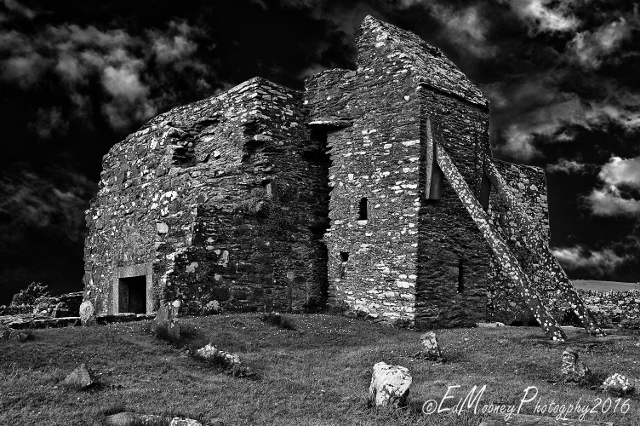

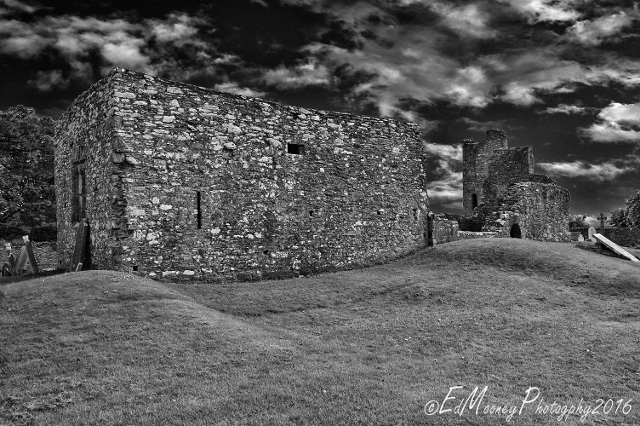
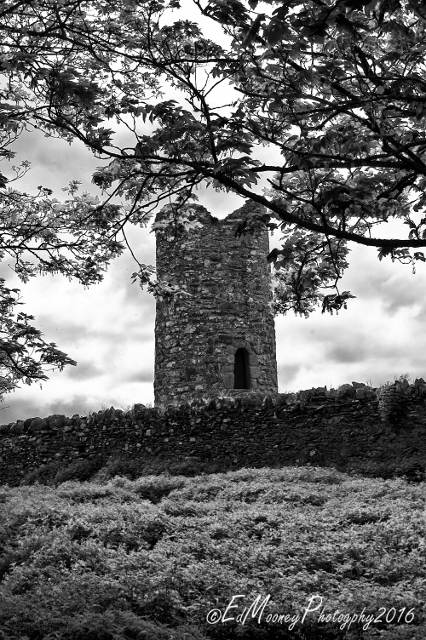
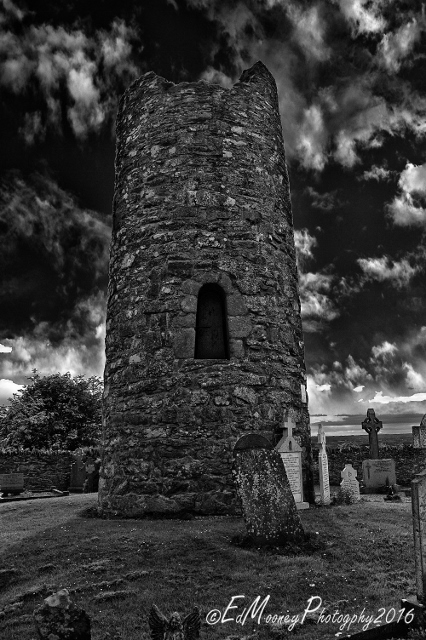

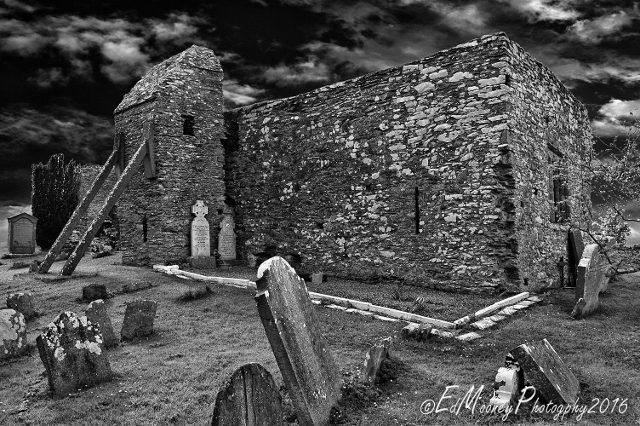
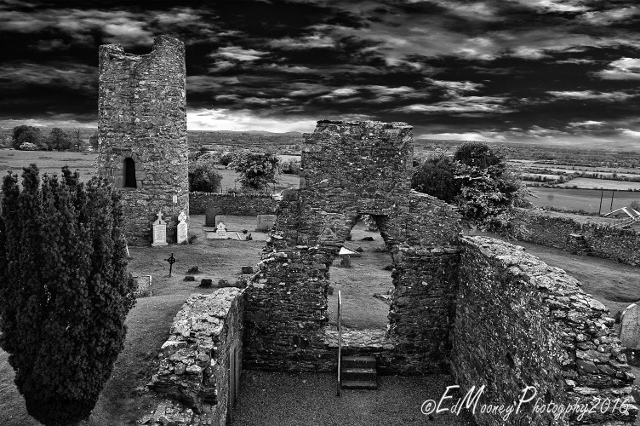

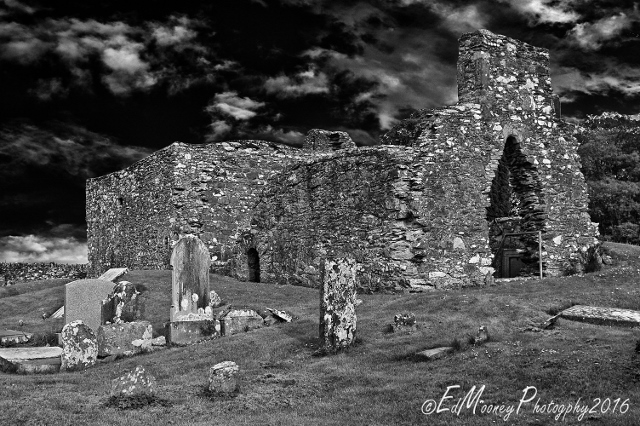
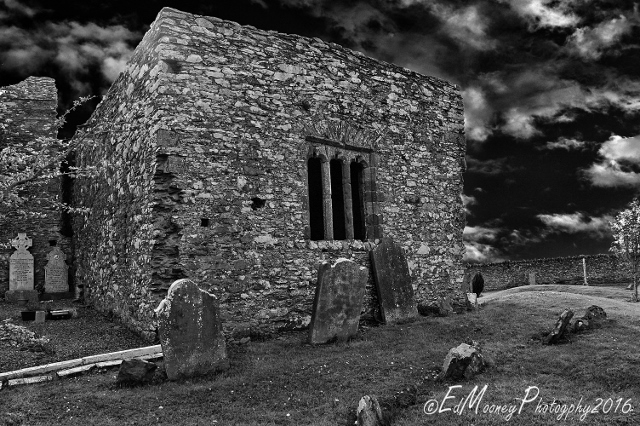
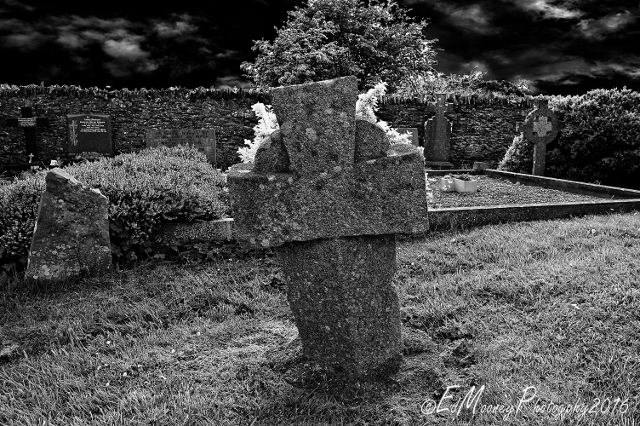

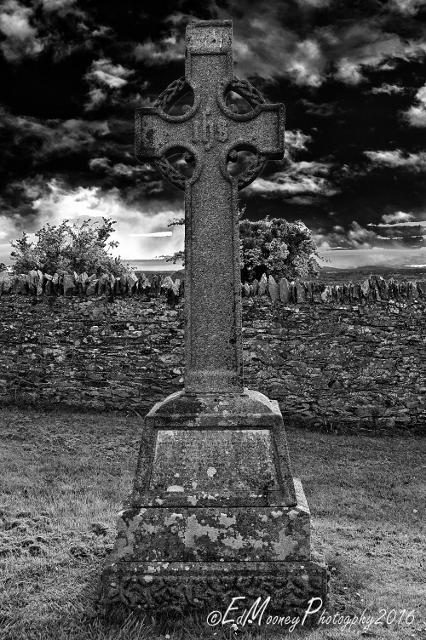
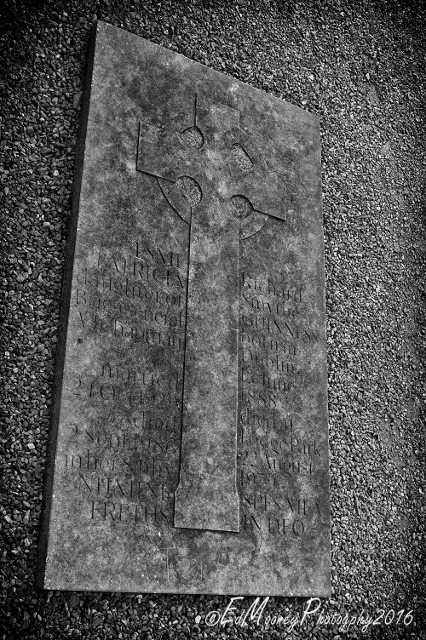



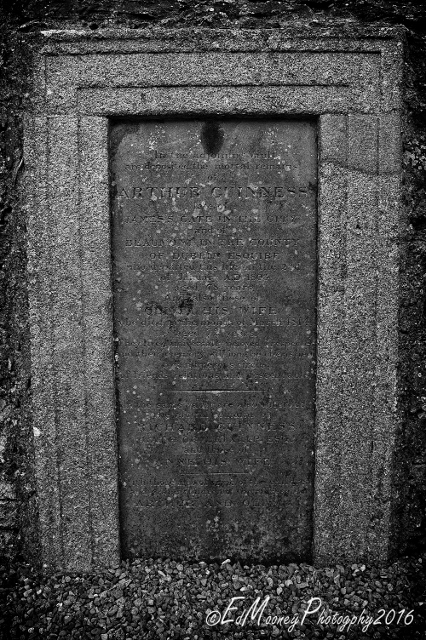
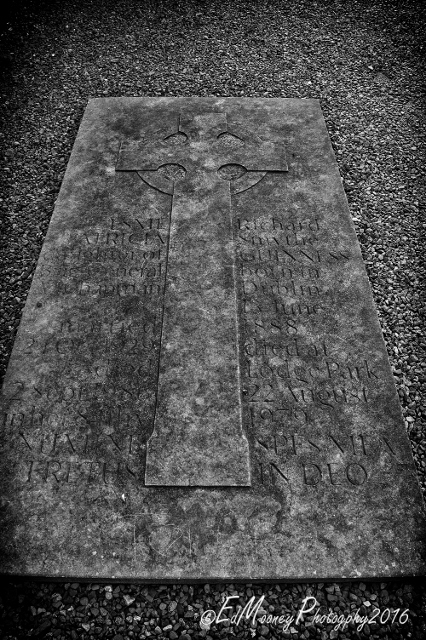
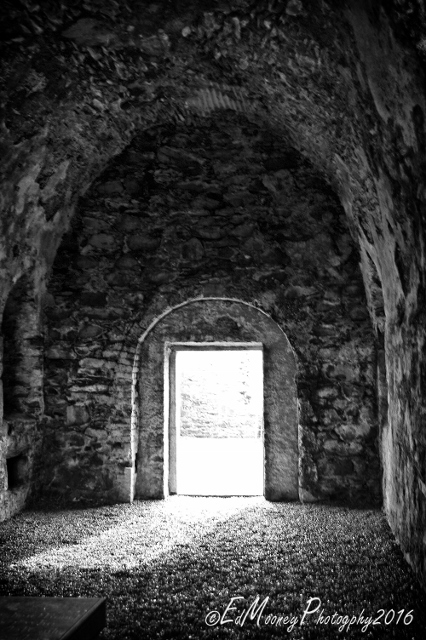
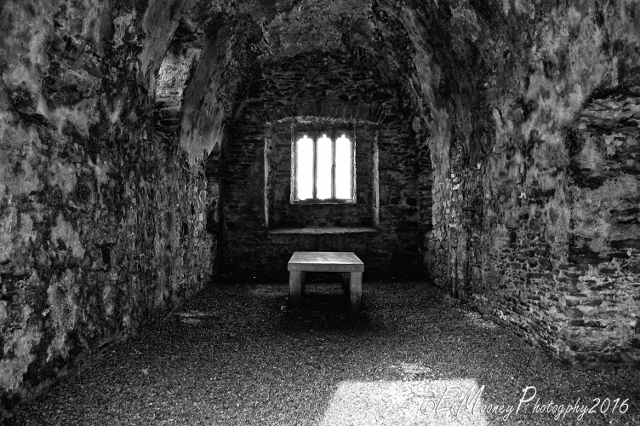
 #
#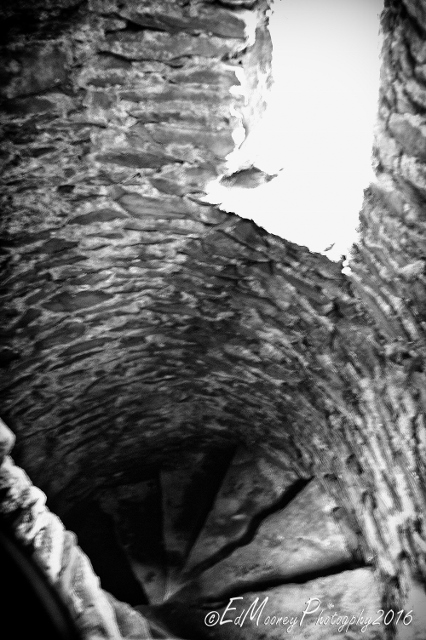
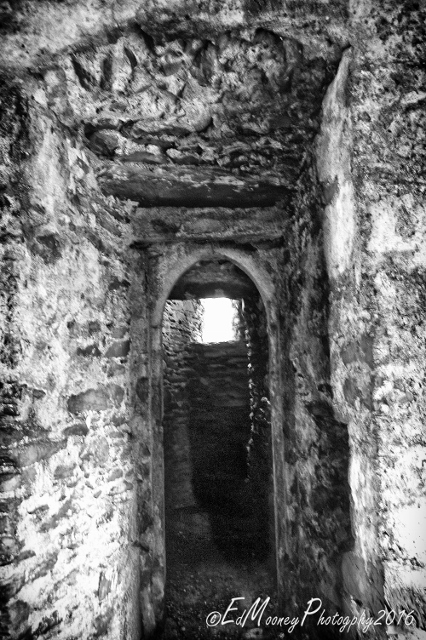
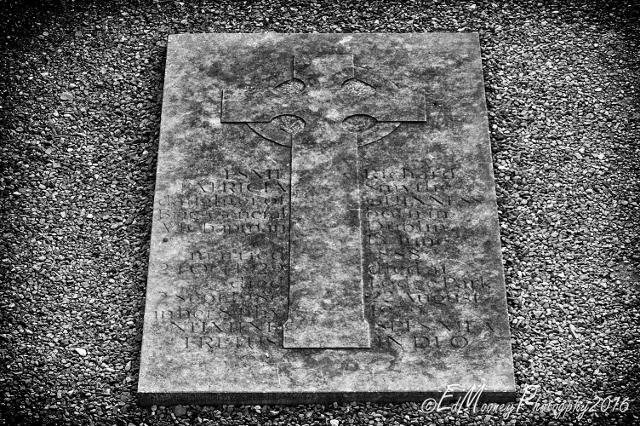
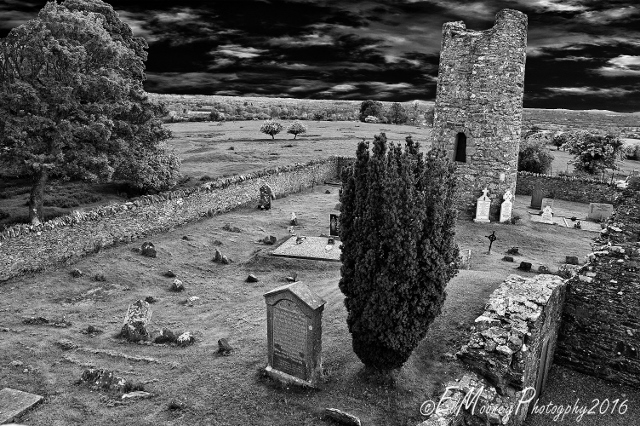



Very cool history.. You do fantastic research…
LikeLiked by 1 person
Ah thanks Rajiv, its my new approach for the year, dig a little deeper and share as much as I can find. It takes a little bit longer to do obiously, but I am enjoying it so far 🙂
LikeLike
Wonderful clicks, I wonder how they look in colour.
LikeLiked by 1 person
I much prefer Mono to colour for old ruins, less is more I guess 🙂
LikeLike
Absolutely. Even the background of sky adding beauty to it.
LikeLiked by 1 person
I like the two hefty beams holding part of the building up! And you’re right about black and white rather than colour. Sepia might be something to look at?
LikeLiked by 1 person
Thanks John, I have used sepia from time to time, depending on my mood and the image, but when you get those blue skies and fluffy white clouds I find mono does the job perfect. If I had an IR camera, it would be ideal 🙂
LikeLike
You’re brave! The photos certainly give off a creepy but interesting vibe.
LikeLiked by 1 person
Not so brave just over inquisitive 🙂
But thanks Marjorie 🙂
LikeLiked by 1 person
That’s a good trait to have Ed. 🙂
LikeLike
Thanks Marje, it has served me well so far 🙂
LikeLiked by 1 person
Love your posts Ed – I’m going to refer you to some of my keen Irish (descendant) genealogists – I’m sure they’ll really appreciate the history and images as well.
LikeLiked by 1 person
Boy, those first three photos are powerful. So rich and evocative!! Whatever technique(s) you use to get those velvetty blacks and stark grays… I really really really really really really REALLY love it! You should have done U2’s Joshua Tree photography!!
C’mon Bono/Edge… get Ed on the phone NOW!! 🙂
LikeLiked by 1 person
LOL, thanks Dan, its stolen from the infra red look, a nice blue sky and fluffy white clouds works wonders. Sadly this is as close as I can get without an IR camera, But it does me just fine. 🙂
LikeLiked by 1 person
Who needs IR when you have your “version.” This is how new art/style is created. Your “stealing” the idea and making something of your own is exactly how all fine arts move forward. What one thinks is their “flawed” version of the things that inspire them become the masterpiece for another after you. Picasso became Picasso because photography ended the era of portraiture and attempted “realism” in painting. So what is something Picasso could do that photography couldn’t? Show two eyes at the same time on one side of a face, show form broken down in Cubist gestures, show surrealist trombones floating in the sky without trick photography… that sort of thing.
Your non-IR, IR looking work is exactly what IS Art!! 🙂
LikeLiked by 1 person
Ah Thanks Dan, Im chuffed. I am finally starting to get my own mojo, when you think back to how I started, then eventually lunged into some not so great Black & Whites. I think that my shots are far more punchey and astmospheric which is what I like.
But we gottaa keep on getting on as they say. Who knows what it will be like in the future? But its the journey that counts 🙂
LikeLiked by 1 person
An artist has the testicular fortitude to be unskilled for a long time and people say you suck, then you arrive at an original style and then everyone acts like they were on your side and thought you were a genius the whole time!
No REAL artist has spent less than 15 years sucking at their passion; Van Gogh sells for hundreds of millions and he sold a single painting (for cheap) in his lifetime because the entire art world of the day thought he sucked because he painted with blunt objects.
You ARE unique and a real artist. Just do your thing and let any/all dilettantes play their foolish, meaningless games…. you do punchy and atmospheric. It is good!!
LikeLiked by 1 person
As always, the ideal combination of interesting history, and detailed photos to explain your investigations. It works well, Ed, and is a familiar formula that has become your ‘signature’.
Didn’t those Vikings have some great names? Sigtrydd Silkbeard! What a moniker.
Best wishes, Pete.
LikeLiked by 1 person
Thanks Pete, I guess so, although I am trying to increase my research a bit this year and make it more informative, It takes much longer, but I think its worth the effort.
Yes them Viking lads had some rather cool names. Sigtrydd was the Viking king of Dublin until Brian Boru came up and bet the hell out of him 🙂
LikeLike
Viking names are great… but I wouldn’t discount the classics. Edward simplified (Ed) is a great name. Simple, easy to say, has a nice woody sound (Monty Python reference)… I think “Ed” could hold his own against “Asger” (spear of god).
I’ll put a fiver down on Ed with an axe over Arvid with a longsword….
LikeLike
LMAO, Im still chuckling. They say the pen is mightier than the sword Dan? Would you still put down a fiver If I had no Axe???
Just a wee biro! 🙂
LikeLiked by 1 person
You have Japanese martial arts training. You would know how to wield the biro in a way that he wouldn’t predict. Thus you would have the element of surprise. If Arvid didn’t cleave you in two on his approach, you could do some serious damage in close hand-to-hand. I’ll put a fiver on Arvid approach and a ten on your hand to hand biro battle.
But even mightier than the pen is talking your enemy down and making friends with him, thus making peace in the world… (until he isn’t looking then you eviscerate him with a bearded axe and sell his family on the open market – to a salt mine – for a decent price, adjusting for inflation…). Y’know… satyagraha!! 🙂
LikeLiked by 1 person
Japanese, Chinese, Indonesian, Fillipino and European, and mostly combat, none of that points based sport stuff. Oh for F’s sake I didnt see that comment comming. You went all Zen on me for a minute and switched straight into a classic Irish tactic, 🙂
I was thinking more along the lines of Duragraha?
LikeLike
I think Ireland’s best weapon is the Irish sense of humor. Every party I have ever gone to that was a real fun hilarious unforgettable evening had an Irishman or Irish woman at the center. Your party isn’t a party until the O’Neills show up! I one spent an evening wandering around Kobe Japan (1998) with an Irish friend and his father from Ireland who was visiting Japan for the first time. His running commentary on what he was seeing still makes my sides ache with laughter all these years later.
“It is better to spend money like there’s no tomorrow than to spend the night like there’s no money!” 🙂
LikeLiked by 1 person
Wise words indeed, I would love to visit japan one day for a good month or two.
LikeLike
Great monochrome shots! Very atmospheric.
LikeLiked by 1 person
Wow, fantastic photos and processing, Ed! I really appreciate your research too. Your posts always draw me in and hold me.
LikeLike
Thanks a mill John, its a labour of love for me, (most of the time). Like anything in life it has its occasional frustrations. But its worth the effort 🙂
LikeLike
So much detail. You must have been hours taking notes!
LikeLiked by 1 person
Spent loads of time on this one, between field notes, editing and going through various manuscripts and books. If I got paid for this I would be on serious overtime Jeni 🙂
LikeLike
By the way, your polldaddy link doesn’t work. I’m opening it on Chrome on a W10 machine. Tried it as http and https – all I get is a bunch of code….
LikeLike
Oh, those stairs! Tricky!!
LikeLiked by 1 person
They most certainly are, even on such a nice day. Most of the building is made from Limestone, so the water likes to hang around and leak out all over the place 🙂
LikeLiked by 1 person
Great photographs!
LikeLiked by 1 person
Thank you so much 🙂
LikeLiked by 1 person
Welcome!
LikeLiked by 1 person
Wow what a place! I couldn’t believe these pics, Ed, just amazing! You have outdone yourself! I think it’s image no 6, with all the headstones leaning at crazy angles, and the play with scale… it just doesn’t look real, like a model or a toy. Otherworldly, that’s what it is, Ed! And you really have gone to town on the research. I’m liking the combo very much!
LikeLiked by 1 person
Thanks a mill Ali. Ive been trying to add more research this year, there are some fascinating texts available. It takes me a bit longer for each post but I think its worth the effort 🙂
LikeLiked by 1 person
It definitely is!
LikeLiked by 1 person
Did you get an email from a Wendy?
LikeLike
Yes I did. Guess you did too. What’s it about? Is it a scam?
LikeLiked by 1 person
I don’t think so, it looks to be legit, if they get the funding. I’m just waiting to hear back about their actual plans. If so it could be great
LikeLiked by 1 person
It could. I’ll email you later. 😊
LikeLiked by 1 person
That’s an interesting point about Briga and Brigid – I kind of knew that there were “other” Brigids, but 14! Still, you’re from Kildare, so I would expect you to know.
LikeLiked by 1 person
They pop up all over the place. Its no wonder that their are so many holy wells around the country associated with her. Most likely not all too the same person 🙂
LikeLike
Yes – that would make more sense. Maybe it was a franchise…
LikeLike
Every time I start to hanker after a round tower I remind myself they don’t make the right kind of furniture any more. Gorgeous pics though 🙂
LikeLiked by 1 person
So true Jane, thats why I prefer the Castles, plenty of right angles. Its just too damn hard to fit those l shaped sofa’s into a Round Tower 🙂
LikeLike
So cool. Love this one Ed! 🙂
LikeLiked by 1 person
Thanks Jewels, glad you enjoyed it 🙂
LikeLike
I can’t believe the little so and so’s have defaced that stone by scratching their names into it. I doubt you had the desire to do so did you Ed!
Criminal.
I love the way that the wall is held up by those two beams propping it up but they have been there so long they are covered in the same moss and fungus that the wall is.
Finally, I have to ask, how many miles do you do chasing around the country looking for these ruins…?
LikeLiked by 1 person
I sure didnt, but I would not object to throwing the little so 7 so’s off the roof for their efforts 🙂
The buttresses are really cool, unusual to see them on a church, As for mileage, dont get me started. I dont do as much as I would like too and I do a hell of a lot more than the wife likes!
It aint easy being me 🙂
LikeLiked by 1 person
Oh the trial and tribulations of The Ruin Hunter…!
LikeLiked by 1 person
My fave place. It’s the end of the Arthur’s Way Heritage Trail which starts in Leixlip (which has a few nice spots of its own, if you’re ever up north!). Daniel O’Connell is reputed to have had a duel near Oughterard as well. https://ardclough.wordpress.com/about/ardclough-history/oconnell-vs-desterre-duel/ for details.
LikeLiked by 1 person
Lol, I lived and worked in leixlip for a number of years, know the place well, although, it has changed dramatically since my day. Thanks for the link, how the hell did I miss that little gem.
LikeLike
Pistols at dawn, Ed. Let’s do it!
LikeLiked by 1 person
Lol, a typical Friday night in lexlip. The Hillers v the Far enders 🙂
LikeLike
Jaysus, if we had pistols there’d be no-one left (nor a sinner to staff Intel or Hewlett Packard. The country would close down overnight!). I guess that’s enough local references for now. Your other readers won’t have a clue what we’re rambling on about 🙂
LikeLiked by 1 person
LOL, guess your right, I wonder would the Captains Inn or the Hitcher qualify as historic ruins if they were still standing?
Until next time 🙂
LikeLike
Well I guess parts of each would indeed have some historic significance (given their ages). Certainly a lot of the main street in Leixlip was cobbled together in the mid-to late 1700s when a lot of development was taking place all over the country, courtesy of our neighbours (cough). The Mall, for example, was linked to one Arthur Guinness. I was never a fan of the Captain’s Inn but the Hitcher had a certain charm (it looked like something out of Tarantino film, though we didn’t appreciate it at the time). Shadows Nite Club, which is now a Lidl store (and I use that spelling deliberately) was where I met my wife. No gags about ‘historic ruins’ please!
LikeLike
LOL, the Hitcher was well named, remember getting cans through the hatch after 11pm. The Rye Vale was our watering hole, followed by a trip to Rockadaddys if you where looking for a shift 🙂
We were so mature back then 🙂
LikeLike
Wonderful old walls with lots of texture – gloomy and atmospheric
LikeLiked by 1 person
Thanks a mill Diane 🙂
LikeLike
Beautiful shots, and great write up too. Thanks
LikeLiked by 1 person
Thank you Max, glad you enjoyed it 🙂
LikeLiked by 1 person
Love this post. I read it carefully. One small peeve is that your lovely images can’t be viewed any larger. I’d love to see the details.
I have a complaint with the new WordPress setup. The only way to make images open larger is to go into Admin – posts – select the image – edit and in display settings select media file. Tech support told me that.
LikeLiked by 1 person
A lot of the changes WP have made are not exactly user friendly. You could try my FB or Flickr pages, there is a link at the end of each post. They might be of use Sherry 🙂
LikeLiked by 1 person
Reblogged this on Daily Echo.
LikeLike
Pingback: Uachtar Ard | oshriradhekrishnabole
Beautiful photos. Thanks for sharing.
LikeLiked by 1 person
Many thanks Don, much appreciated.:-)
LikeLiked by 1 person
Very evocative photos, Ed, and you were a dare devil to get out on that roof. Think what might have been left if the dissolution of the monasteries had never happened!
LikeLiked by 1 person
Thanks Noelle, I’m sure if the dissolutions hadnt happened, Cromwell would have spent alot more time in Ireland, blowing stuff up 🙂
LikeLike
Would’t you just like to go back and throttle that guy?
LikeLiked by 1 person
Nah, I think it would be better to go back in time and beat his parents. Put a stop to him completely 🙂
LikeLike
Thanks, Ed, for this thorough and interesting piece on these stone buildings of the past in Ireland. I admire your intense research. — Suzanne Joshi
LikeLiked by 1 person
Thank you, I appreciate it 🙂
LikeLike
You’re most welcome. 🙂 — Suzanne
LikeLiked by 1 person
I love the history you’ve shared with us, and the photographs are stunning.
LikeLiked by 1 person
Much appreciated Dan, thank you.
LikeLiked by 1 person
Really good work.
LikeLiked by 1 person
Thank you 🙂
LikeLike